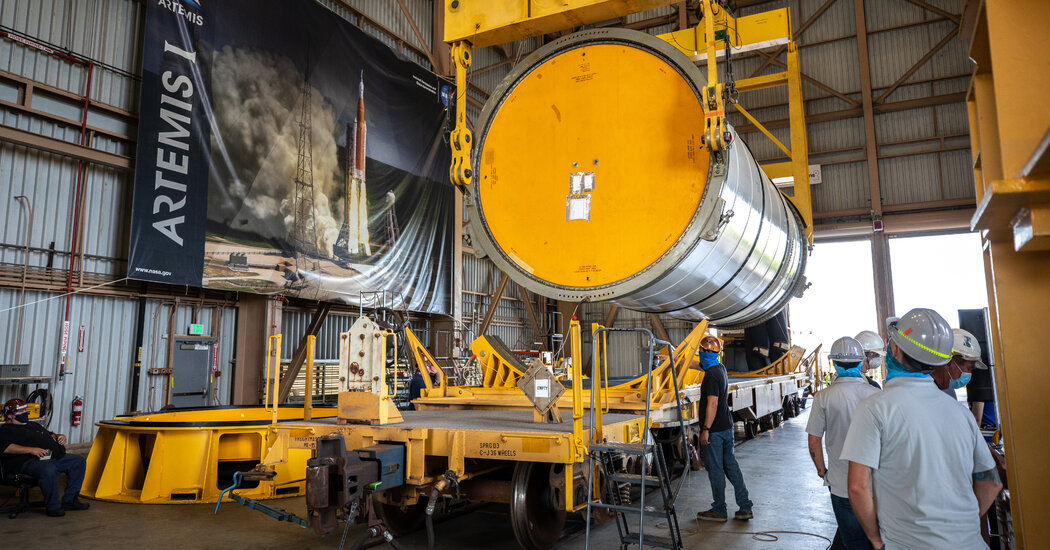NASA has spent years and billions of dollars developing a giant rocket known as the Space Launch System, designed for it. Take the astronauts to the moon And maybe further away in the solar system one day. But the missile’s first launch – an unmanned test flight that will go to the moon and beyond – won’t be launched until at least November.
On Saturday, though, NASA is scheduled to deliver a fiery show as it is doing a critical test: igniting all four engines of the boost stage for up to eight minutes, and simulating what would happen during an actual launch into orbit. However, the booster will still be securely anchored to a test stand at NASA’s Stennis Space Center in Mississippi.
When is the shooting and how can I watch it?
The test is scheduled to launch on Saturday 5 p.m. ET. NASA TV will broadcast coverage of the test, which begins at 4:20 p.m. A press conference is scheduled about two hours after the test.
What is the Space Launch System and why does NASA say it needs the missile?
The Space Launch System is the equivalent of the 21st century Saturn V, which took NASA astronauts to the Moon in the 1960s and 1970s. Although there are many other rockets available today, they are too small to launch a spacecraft that can carry people to the moon. (A possible exception is Falcon Heavy from SpaceX, But the human lunar mission would require two separate launches bearing pieces that stick together in space or head separately to the moon.)
The Falcon Heavy can lift up to 64 metric tons into low Earth orbit. The initial version of the SLS is slightly more powerful, capable of lifting 70 metric tons, and future versions of the missile will be able to lift up to 130 metric tons, more than the missiles that carried Apollo astronauts to the moon.
Although the Space Launch System would be costly – up to $ 2 billion to launch a single-use missile – Congress has provided steadfast financial support for it so far. Proponents contend that it is important for the government to own and operate its powerful deep space rocket, and that parts of the system have been embraced by companies across the country, spreading the economic benefits to many states and congressional districts.
The Space Launch System is a key component of the Artemis program, which is a program to return NASA astronauts to the moon in the coming years. Although the president Trump has pledged to make the trip by the end of 2024Few expected that NASA would actually stick to this timeline, even before President-elect Joseph R. Biden Jr. was elected.
Why is the missile so late?
When NASA announced plans for the Space Launch System in 2011, the first launch was scheduled for 2016. As is customary in new rocket designs, development encountered technical difficulties, such as the need to develop procedures for soldering pieces together as large as these Located in the missile. NASA too Work on the missile has stopped For a period of last year during the early stages of the Coronavirus outbreak.
As the first launch date fell several times, prices rose. NASA has so far spent more than $ 10 billion on the rocket and more than $ 16 billion on the Orion capsule where the astronauts will sit.
Why is the fire test important?
The test fire is part of what NASA calls „Green Run,“ a series of tests for a fully assembled booster phase. The same booster will be used on its first flight into space, so engineers want to make sure it works as designed before launching it.
What can go wrong during the test?
Just like with a real launch, technical bugs happen. In an earlier test, known as a wet rehearsal, in which the countdown was fully simulated except for the engines to ignite, things went almost fine. But in the last few seconds, one of the fuel valves hasn’t shut down as quickly as expected. It turned out that the temperature was slightly lower than expected, which made the valve more difficult to rotate. The program has since been modified.
The worst case would be if a malfunction destroyed the booster. This would add years of delays to the program and renew calls for NASA to consider alternatives.

„Total Social Media Ninja. Introvertiert. Schöpfer. TV-Fan. Preisgekrönter Unternehmer. Web-Nerd. Zertifizierter Leser.“

